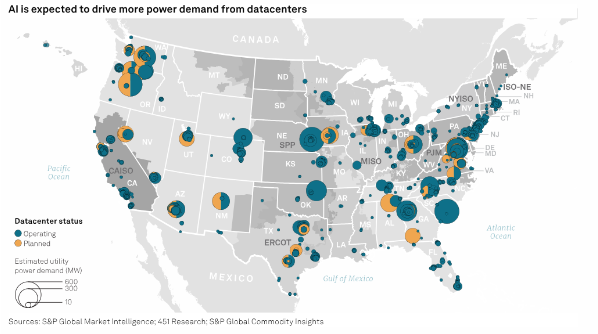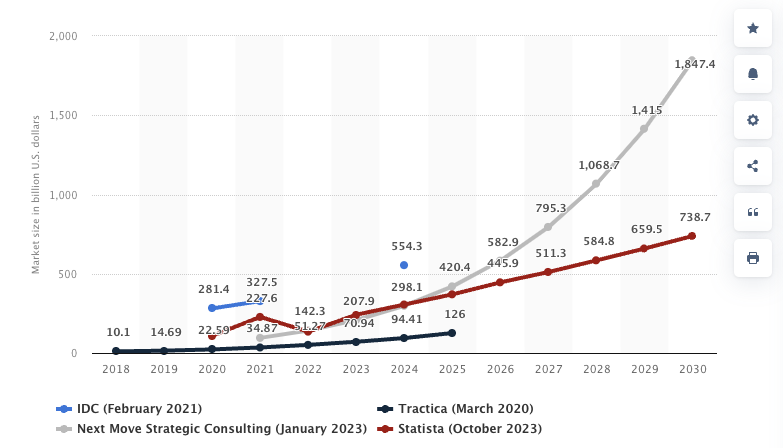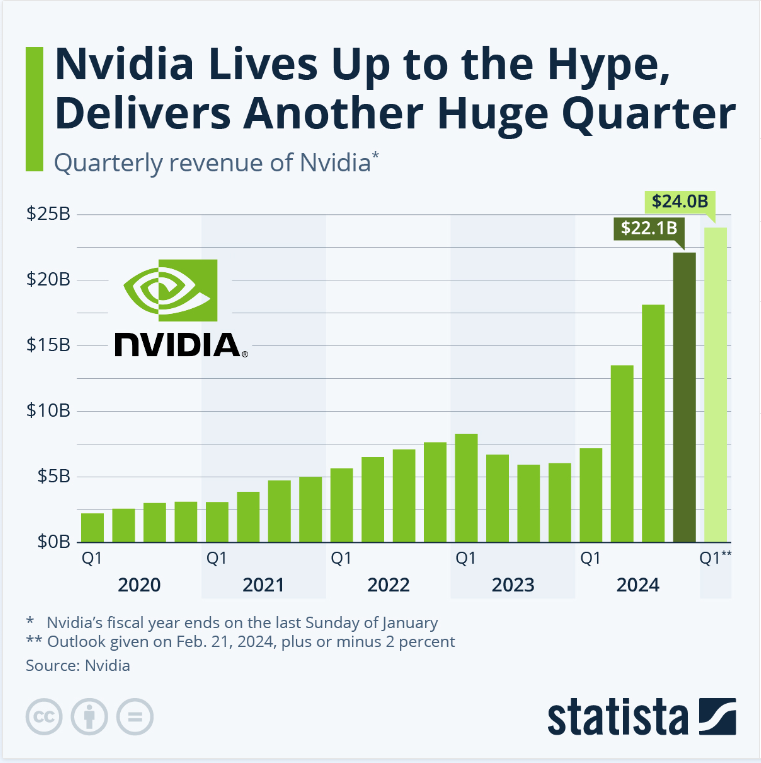As Artificial Intelligence continues to captivate industries worldwide, a new reality emerges: beneath its potential lies a significant and overlooked cost, the cost to power it. It brings up the question if AI is truly a sustainable and financially sound investment for businesses.
The costly electricity consumption required to power AI systems should be considered before AI is praised as a tool of the future. Companies already are paying for equipment, payroll, and other fixed costs; implementing AI into companies is going to be the next major cost consideration. Is it worth the large capex investment?
SERVER & ELECTRIC COSTS
To implement AI into your company, a built in software solution can range from $5,000 to $150,000 to start up with maintenance costs considered after. AI consumes a very large amount of electricity, which requires a large amount of money to fund. As datacenters incorporate AI and many planning to in the U.S., more power is demanded.

Source: S & P Global
Depending on many factors, AI’s energy costs are unpredictable and many are unsure of the true cost of AI in terms of money with so many variables to consider.
With the excitement of the versatility of Artificial Intelligence, research on its cons are limited and many are not fully understood yet due to it just recently becoming a trend. People attest how it’s going to obstruct human interaction or take jobs, but the real downside of AI is its energy cost.
Data Scientist Alex de Vries, has recognized the obscene amount of energy being used to power AI and has taken time to research. De Vries states:
“By 2027 worldwide AI-related electricity consumption could increase by 85.4–134.0TWh of annual electricity consumption from newly manufactured servers.”
He compares this to the annual electricity consumption of countries such as the Netherlands, Argentina and Sweden.
Market size and revenue comparison for artificial intelligence worldwide from 2018 to 2030 (in billion U.S. dollars)

Source: Statista
This chart examines the expense of AI and its rapid growth expected in the coming years.
With large amounts of energy use, comes large costs on electric bills.
REVENUE VS. VALUATION: ARE AI COMPANIES OVERVALUED?
AI startups have caught the attention of investors. According to Crunchbase, more than a fifth of all venture funding in February went to AI companies with $4.7 billion invested towards the sector. Crunchbase states:
“There are many concerns in venture capital circles that AI is the next bubble, as companies in this sector continue to raise massive rounds in quick succession and at huge valuations.”
Are AI companies overvalued?
Companies don’t want to be left out of the Artificial Intelligence investing frenzy. Amazon took the bite and invested $2.75 billion into the AI startup Anthropic being their largest venture deal ever. Anthropic is forecasted revenue of more than $850 million next year.
Large amounts of money are being poured into AI, but the value is prevalent. Companies have benefited immensely from AI, the biggest example of all is Nvidia, an AI chip making company, powering the AI revolution.
“Accelerated computing and generative AI have hit the tipping point. Demand is surging worldwide across companies, industries and nations,” Jensen Huang, founder and CEO of Nvidia, said in a statement, “Vertical industries — led by auto, financial services and healthcare — are now at a multibillion-dollar level,” he added.
Nvidia is now trading with a market cap above $2.5 Trillion, making it larger than Tesla and Amazon combined. A company that only five years ago had a market cap of $100 billion. Despite its exponential trajectory, will it plateau?

Source: Statista
AI investments are bold considering many of the AI technology is not yet to be proven successful. For example, SoundHound uses AI for conversational experiences such as in drive-thrus to make the ordering process more efficient, the risk of this being a success or not is unpredictable. Soundhound has a market cap of $1.65 billion with an enterprise value of $1.55 billion. They had a significant net loss of $89M with a $46M revenue so it is being reconsidered by investors.
With only $11 million in revenue, Stability AI, the company behind the open-source AI image generator Stable Diffusion, was valued at $1 billion in 2022. The startup raised at least $101 million from investors like Lightspeed Venture Partners and Coatue Management in a seed round in July 2022. However, Stability AI has been struggling to raise funding at a $4 billion valuation in 2023.
AI Startup, Hugging Face, said on Thursday it was valued at $4.5 billion in a $235-million funding round. They have $50-70 million in annual revenue. Hugging Face’s co- founder and CEO Clément Delangue recognizes the demand is high and their growth is increasing rapidly. Delangue said:
“In five years, every tech company will be an AI company.”
Given its substantial costs and significant investments, Artificial Intelligence is an unpredictable yet undeniably lucrative technological pursuit.
UNDEFINED PATH TO RETURN ON INVESTMENT
Major companies have had to consider the great capital expense that comes with the implementation of AI.
“According to analysts at Raymond James, “AI inflation” is driving up capital expenditures (capex) for big tech, with Amazon (AMZN), Meta, Microsoft, Alphabet and Oracle (ORCL) expected to spend $199 billion on capex this year, about 28% more than in 2023.”
Companies like Microsoft, according to the Washington Post, have spent $14 billion in the most recent quarter with larger investments on the horizon. Many companies alike are spending the same, if not more.
Investors are being careful on what companies to trust when it comes to the ROI of AI systems being installed because the investments are in the billions.
With Mark Zuckerberg officially showing interest in bringing Artificial Intelligence to Meta, investors fear a similar case to when Zuckerburg introduced the metaverse. The metaverse was far from successful, losing the company $46.5 billion according to Fortune. Meta is already showing signs that the AI installments are costing more than originally anticipated.
According to Business Insider and Meta’s first-quarter report, Meta originally expected to spend roughly $30 billion and $37 billion, but with new large investments towards research and development, that number is now around $35 to $40 billion for each quarter.
With all of these companies pouring dollar signs into AI, will there truly be any return on investment?
The true cost is not known yet. When Zuckerburg introduced the metaverse he believed it would pay off, when it certainly did not, so we can only be so sure.
The initial excitement and competitive edge AI brings to the table is instigating companies to invest and start now. With billions going into these systems it is a shot in the dark. Although AI softwares, like the free to use AI ChatGPT, have already exceeded the 100 million user mark.

Source: Venture Beat
From a business perspective, the electric bill alone to power AI is something to be considered when implementing it. It brings efficiency to the workplace and the ability for employees to get work done faster. Even with pre-built AI softwares, which is accessible to the public either for free or at a low cost, the energy behind the AI is being charged somewhere either in bill form or in terms of impacting the environment.
Conclusively, when thinking of bringing AI into your business, many factors must be considered before taking on this electric powerhouse. Between the electric bill, the software, and the energy costs, Artificial Intelligence has a great impact on the world of business and its operations. Optimistically in the coming years as alternative energy sources develop, perhaps a world will exist where AI can be an effective business tool without the big dollar sign and major environmental consequences.

